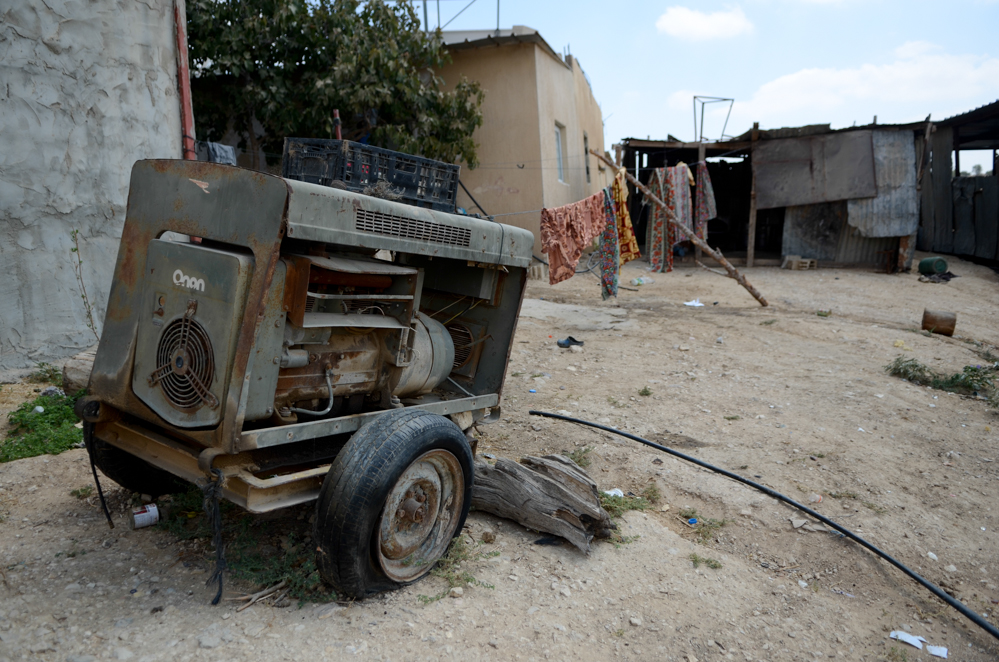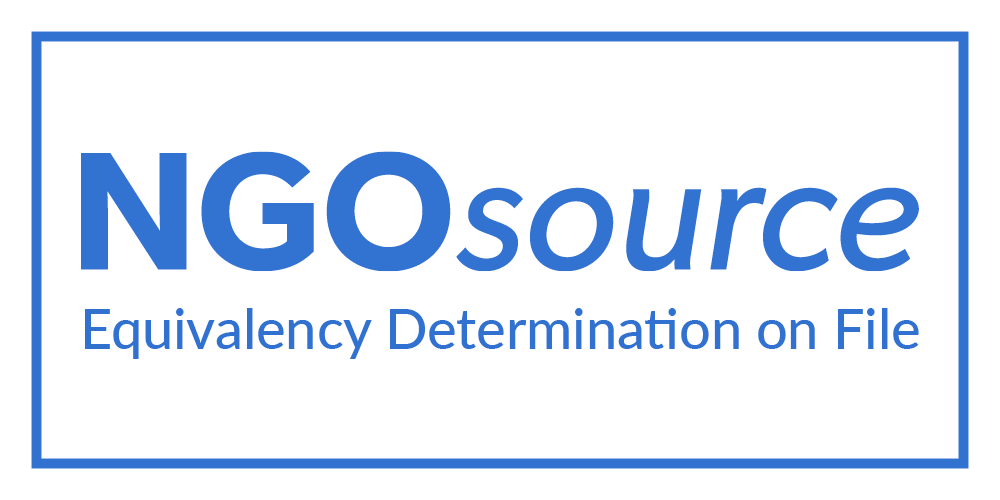How have the residents of the 13 ‘Abu Basma’ villages benefitted from ten years of recognition?
Read this briefing paper in PDF
- Majority of the ‘Abu Basma’ villages are not connected to the water, electricity or sewerage networks.
- Most of the villages lack paved roads, libraries, social welfare services and public transportation.
- The Abu Basma Regional Council was split into two in 2012, partly in order to deny the right to vote to the population of the villages, which have had no local representation in ten years of recognition.

A generator in a Bedouin village in the Naqab/Negev. Due to the state's negligence, tens of thousands of Bedouin citizens remain without access to the electricity network or other basic services (Photo by Adalah)
In late 2003, the Israeli Government decided to establish the ‘Abu Basma’ Regional Council in the Naqab/Negev region of southern Israel. Placed within its jurisdiction were a number of Arab Bedouin villages which the government had newly recognized, after a long struggle by Arab Bedouin residents of the Naqab. Since 2003, the government has granted official recognition to a total of 13 Bedouin ‘Abu Basma’ villages. In 2012, the Interior Ministry decided to split the Abu Basma Regional Council in two, creating the Qasoum and Naveh Medbar Regional Councils.
The 13 villages are (ordered according to the date of recognition): Abu Qreinat, Qasr al-Ser, Bir Hadaj, Tarabin, Umm Batin, Makhoul, Dreijat, Mulada (Al-Atrash), Kuhleh, Al-Sayyid, Al-Fur’a, Abu Tulul, and Abdeh. They have a combined population of approximately 36,000 people. According to the regional council’s website, the council is responsible, in addition to these 13 villages, for “all the unrecognized villages in relation to the following areas: education, social welfare, and environmental protection.” There are approximately 35 unrecognized Bedouin villages in the Naqab, with a total population of around 90,000 people. Their residents are denied basic infrastructure and services by the state as a matter of policy due to the unrecognized status of their villages.
Contrary to expectations that recognition would lead to improvements in conditions in these villages, especially in terms of basic infrastructure and services, today, ten years after their official recognition, residents have seen little-to-no improvements. In most respects, the deprived state of these villages remains just as it was when they were unrecognized. Despite their recognized status, the planning authorities have continued to pursue their policy of denying villagers’ applications for residential building permits, with the result that there is little, if anything, to differentiate the ‘Abu Basma’ villages from the unrecognized villages.
Infrastructure: Most of the 13 ‘Abu Basma’ villages remain unconnected to the water, sewerage and electricity networks
- The houses in 11 of the 13 villages are not connected to the state water network. Their residents have to obtain their water from collective water points. Some lay plastic piping, at their own expense, from these points to their homes. The cost of laying this pipework is extremely high, while the water pressure is very low. The pipework, which is laid above the ground, is constantly vulnerable to damage and the water is heated to high temperatures by the sun in summer, making it an inefficient way of transporting water. Just one of the villages, Tarabin, is connected to the water network, while one more, Dreijat, is currently being connected.
- 12 of the villages (excluding Tarabin) have no paved roads and work on paving the roads has not even begun. In 2011, after Magen David Adom ambulances had refused to enter Bedouin villages in response to emergency calls due to the poor state of the roads, Adalah wrote to the Ministry of Health asking for it to supply ambulance vehicles that can contend with the rough terrain in the villages.
- Of all the ‘Abu Basma’ villages, only Tarabin has yet been connected to the electricity network. Residents have had to supply their own electricity using generators powered either by diesel or solar panels. In both cases, the cost of the electricity is exorbitant, while the amount of electricity produced is insufficient to power basic modern electrical appliances.
- Since the Abu Basma Regional Council was established, the local planning and building committee has not issued any residential building permits to the residents of the 13 villages. Residents are therefore compelled to build their homes without permits, to which the state authorities have responded with wide-scale home demolition campaigns against them, leading to anger and often to clashes with the police.
- The village of Al-Fur’a, for example, which has a population of around 4,700, is not connected to the water, electricity or sewerage networks. It has no health clinic, public transportation or post office.
Thus, in terms of basic infrastructure and services, the ‘Abu Basma’ villages are still no better off than the unrecognized villages a decade after receiving recognition. See the table, below, for a detailed comparison of conditions in the ‘Abu Basma’ villages and a sample of the unrecognized villages.
Health and infant mortality rates
The dire situation of the general infrastructure and the lack of health clinics in the ‘Abu Basma’ villages, including ‘mother and child’ clinics (which provide preventive health services and specialize in pre- and post-natal care), has resulted in elevated infant mortality rates among their residents, compared to the Israeli average. According to data published by the Israeli Central Bureau of Statistics, in 2007-2009, the infant mortality rate among the Bedouin in the Naqab was 150% higher than the overall rate among Arab citizens of Israel, and 375% higher than the rate among Jewish citizens of Israel.[1] The Bedouin community in the Naqab has an average infant mortality rate of 10.5 deaths for every 1,000 infants, compared to a rate of 3.8 deaths for every 1,000 Jewish infants born in the Naqab.[2]
Only Tarabin has been connected to the sewerage network, while in many of the remaining 12 villages, raw sewage has pooled into putrid bogs, creating serious health and environmental hazards, an unbearable stench, and vast swarms of flies and mosquitoes. In 2012, Adalah wrote to Rahmeem Youna, the head of the Abu Basma Regional Council, an appointee of the Interior Ministry, to demand that an immediate solution be found to the river of open sewage that runs through the center of Umm Batin. Further correspondence led to no solution to the problem, and Adalah is currently preparing a court petition in the case.
Education
The majority of the ‘Abu Basma’ villages still have no public transportation, social welfare services, post offices or banks. Five of the 13 villages have no high school, and eight have no public library, or even school libraries. The existing elementary and high schools are often housed in temporary buildings and are poorly equipped.
In terms of educational achievement, just 48% of the villages’ school pupils who complete their high school education obtain a matriculation certificate (the Baghrut, a requirement for higher education in Israel). However, the Bedouin villages in the Naqab are plagued by the highest drop-out rates in the country, and therefore many children do not even take the matriculation examination. According to a report published by the Adva Center, only 64.7% of children from the Arab Bedouin villages in the Naqab complete their education to high-school level, compared to 81.6% of children from all Arab towns and villages in Israel, and 93.5% of children from Jewish towns and villages.[3]
A report produced by the Knesset’s Information and Research Center in 2010 stated that in the Bedouin villages in the Naqab in general, and in the ‘Abu Basma’ villages in particular, there is an acute shortage of drop-out counselors in schools, despite the alarming drop-out rates.[4] All the schools in the ‘Abu Basma’ villages combined have just two drop-out counselors, whereas they should have at least 5.2 counselors’ positions based on the Ministry of Education’s own criteria.
In July 2013, Adalah petitioned the Supreme Court on behalf of the parents of pupils from seven schools in the ‘Abu Basma’ villages of Umm Batin, Kuhleh and Al-Sayyid to demand that the schools be connected to the regional electricity network. The petition argued that the failure to supply the schools with electricity harmed the children’s education and their right to a suitable and appropriate education. Currently, the schools get their electricity from private generators for only a few hours a day. The amount of electricity is limited and constant interruptions in the supply causes mechanical problems in the generators that prevent air conditioners, computers, internet services and laboratories from working properly.
Continued denial of a democratically-elected regional council
Since its establishment, the Abu Basma Regional Council has been administered by an appointee of the Interior Ministry, and elections to the council have yet to be held, ten years after its establishment. All members of the regional council have been appointed by the Interior Ministry, and all heads and most members have been Jewish Israelis. In 2010, Adalah and the Association for Civil Rights in Israel (ACRI) petitioned the Supreme Court against the ‘Abu Basma Law’, an amendment to the Regional Councils’ Law (Date for General Elections) – 2009 that was made specifically in order to give the Interior Ministry the prerogative to indefinitely postpone the first elections to a regional council. The petition argued that despite the law’s general wording about “new regional councils”, its actual objective is to prevent free elections from being held to the Abu Basma Regional Council.
The petitioners are asking the court to order the Interior Minister to announce the holding of democratic elections in the regional council as soon as possible. On 9 February 2011, the Supreme Court ordered the first elections to the Abu Basma Regional Council to be held by 4 December 2012 at the latest. Rather than abiding by the court’s ruling, however, the Interior Ministry employed a further tactic to avoiding the elections, and in the run-up to the scheduled elections divided the council into two new regional councils, which it named the Qasoum and Naveh Medbar Regional Councils. The administrations of two new councils inhabit the same building as the former Abu Basma Regional Council, and have just been located on different floors. As a result of this tactic, elections have been delayed yet again, contrary to basic democratic principles and the rights of the Arab Bedouin who live under the jurisdiction of these two new government-appointed councils.
Table comparing services and infrastructure in five of the ‘Abu Basma’ Bedouin villages [5]
|
Village |
Abu Tulul |
Al-Fur’a |
Mulada |
Abdeh |
Kuhleh |
|
Population |
5,000 |
4,700 |
3,500 |
1,000 |
250 |
|
Residential building permits |
0 |
0 |
0 |
0 |
0 |
|
Water infrastructure |
Central water point |
Central water point |
Central water point |
Central water point |
Central water point |
|
Electricity infrastructure |
None |
None |
None |
None |
None |
|
Sewerage infrastructure |
None |
None |
None |
None |
None |
|
Paved roads |
0 |
0 |
0 |
0 |
0 |
|
General health clinic |
1 |
0 |
1 |
1 |
0 |
|
‘Mother and child’ clinic |
1 |
0 |
1 |
0 |
0 |
|
Post office |
0 |
0 |
0 |
0 |
0 |
|
Bank |
0 |
0 |
0 |
0 |
0 |
|
Public transport |
None |
None |
None |
None |
None |
|
Social security services |
0 |
0 |
0 |
0 |
0 |
Table comparing services and infrastructure in five ‘unrecognized’ Bedouin villages [6]
|
Village |
Wadi al-Na’am |
Tel Arad |
Khasham Zanna |
Al-Sira |
Umm al-Hieran |
|
Population |
10,000 |
Read more: |














